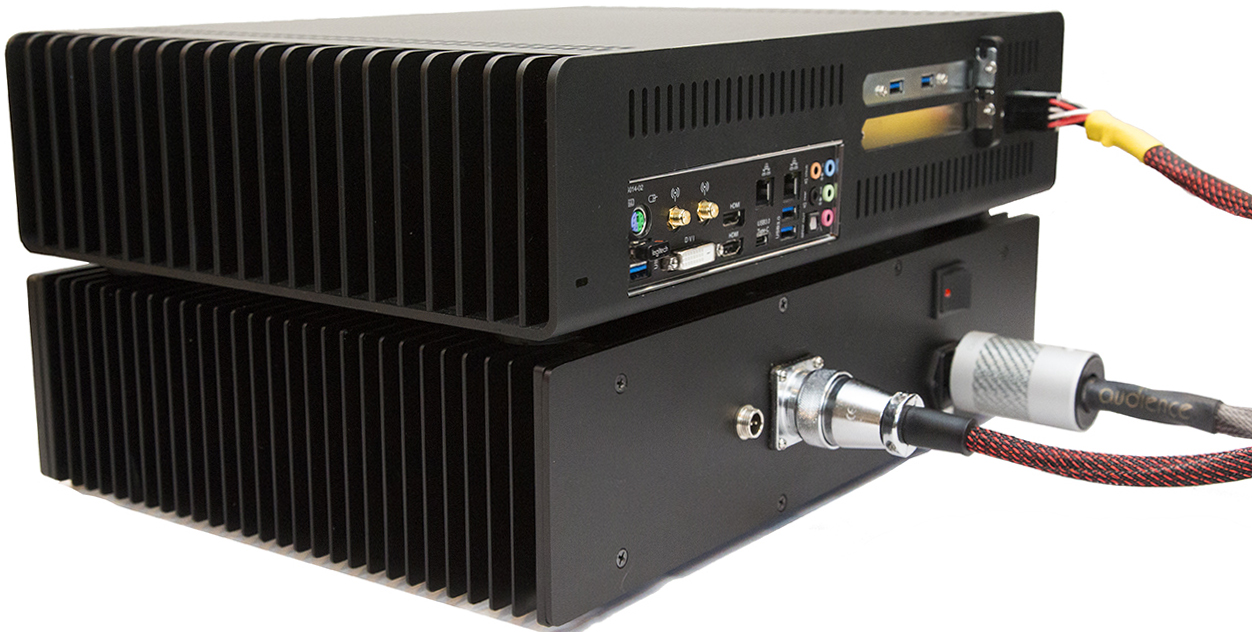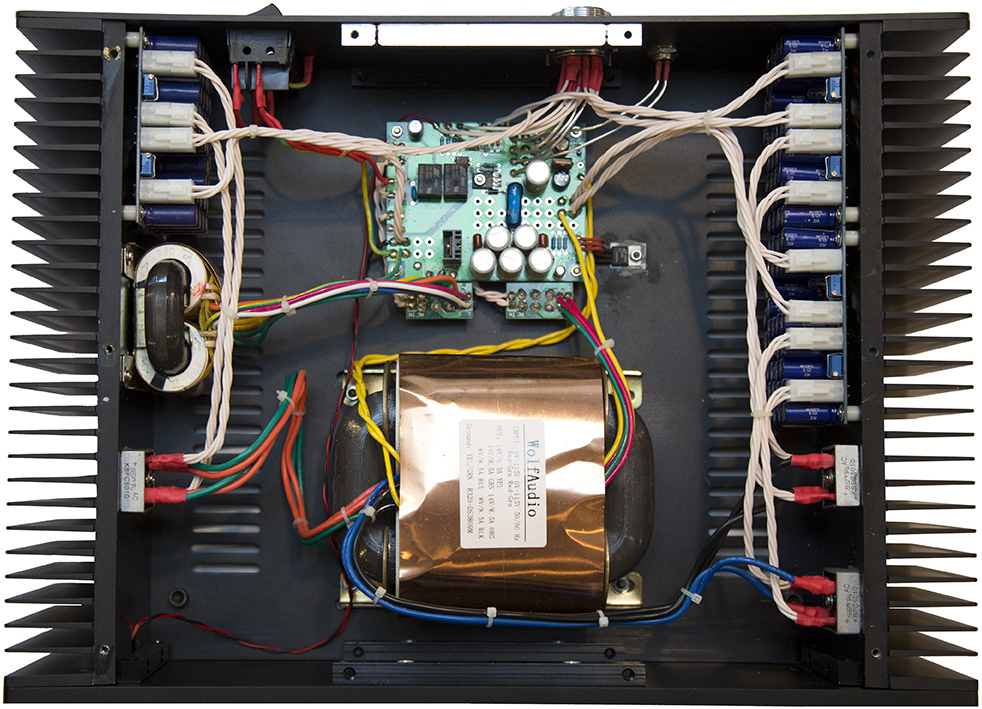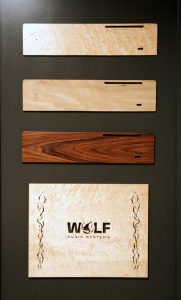About the Red Wolf hardware
Wolf servers are cutting edge in terms of capacity and speed. Joe is a movie junkie, so he has approximately 70 terabytes of capacity in his home server system! He demands instant access to music, and in my experience the Red Wolf queued up music faster than any device I have ever used, even disc players. The response was so quick that it seemed I had hardly clicked the mouse to select the song and it was already playing. If you are one of those people who detest a few seconds wait as the digital library is being searched, the selection found and then buffered to play, look no further than an Red Wolf – you literally will never have to wait.
However, speedy computers are not just about selection of songs, but playback of songs. Regarding the quality of parts other than wiring, Joe states, “Component choice has a large part to do with performance. We have found differences in sound up to 20% based on brand. Timings of CPU and RAM are also a concern. Even when building with known components we have to be careful, because slight manufacturing differences can have an effect on the sound. We went through a couple weeks recently where things sounded off, only to find that the batch of hardware we purchased had some capacitors that were just off.” A standard computer is designed to do all tasks acceptably, whereas a Wolf server is designed to do audio and video exceptionally. Having enough RAM to access not only a song but also an album reduces disc I/O contention, according to Joe. Following the “dirty core” philosophy, some specific cores are freed up to do audio only, while others are assigned to general tasks.
A taste of the Wolf Audio user experience
Is the Red Wolf worth the price tag? In my experience it seems so. Not only are you getting a sea change in sound quality, you are morphing your listening experience, and adding a commensurately high-end video experience. To have the real user experience of the Red Wolf, I took my external back up drive with my music and jacked it into the back of the server. Again, Joe was on the phone and remotely accessing the Red Wolf; this guy seems bent on demonstrating nearly 24/7 support with his immersive computer system/Media Center experience. In moments my files were downloading at a rate I’ve never seen before. The Red Wolf is lightning fast, the fastest personal computing system I’ve seen. It took a fraction of the time for the files to move to the Red Wolf that it took to get them moved onto my upstairs Mac.
Joe gave me a crash course tutorial that was so extensive that it began to make my head spin. JRiver, he told me, is created by people who know database development, and it is far more robust in putting power into the hands of the user than Roon or JPlay. He runs his entire household’s multi-room, multi-system AV experiences from the Red Wolf. I didn’t expect it, but once I put my file collection on the Red Wolf on the “Shuffle” setting and hit play, the 23” Lenovo display I plopped down on the floor next to my listening chair, tethered with a 25’ HDMI to the Red Wolf, began showing visuals of the artists I was hearing! I found myself extremely gratified, even though I consider myself an audio guy and do not seek videos of performances. I usually listen to audio playback only and read if I desire more intellectual stimulation. However, I found that while the images did not alter the sound, I was happy to be seeing the performers’ profiles outlined in images.
The user experience
The type of keyboard and mouse to navigate the Red Wolf server is important. The monitor and keyboard were cheap, costing a total of $201, to get me started. Joe Amazoned a 25’ HDMI cable to me so I could keep the server front and center while placing the monitor nearby. I could’ve, if I wished, used a large screen TV for all interaction with the Red Wolf, which is a recommended method. However, in my room I have projection and it’s less desirable to use projection bulbs for that purpose. I elected to have a monitor close by the listening chair. The only drawback to this method is that the presence of the monitor might displace a seat to the side of the listener, which may affect group listening seating arrangements. I consider this a small issue if the bulk of listening is done individually.
The Red Wolf was so beguiling that it nearly pulled me into a full immersion AV listening experience; I strongly considered splurging for a huge TV. I can see where the Red Wolf experience leads and it’s a fun place, to have perhaps a 60-65” 4K visual experience while hearing the super-lifelike audio of the Red Wolf. I have gone decidedly lowball on my visual end of the system. I built the room for audio, but smartly included what was necessary to run 7.1 surround. I went inexpensive on the video components by using sets of Magnepan MGMW speakers (at the time $300/pair) for the side and back surrounds, and a more capable Legacy Silver Screen Center Speaker in front. My projector is a Panasonic “high def capable” second hand variety. I watch a movie about once every six weeks. The screen, which I built myself for $90, is indistinguishable from a $1,200 manufactured one to the untrained eye and gives me a 100” viewing experience. The drop down to a 65” screen would be tough, but the video quality would be amazing compared to the tired old pixilated viewing I endure now. I was this close to pulling the trigger on the Red Wolf and big TV, even though I shouldn’t.
In terms of audio playback, the Red Wolf is so fast that the split second one song ends the next is begun. I suppose a second or two of buffering can be added to allow a mental transition (Per Joe: it can be configured to as long or short as you want. -Pub.); it’s a bit jolting to go from a symphony to classic rock in a heartbeat when on the “Shuffle” mode. But one gets used to it, as with many other idiosyncrasies of components. I would far rather have to keep up with my server than mentally wait for it to move on to the next track.
The sound
The sound of the Red Wolf Red Wolf was, in a word, scrumptious. There were no artifacts of digital processing evident, and the server worked without a hitch, transitioning between tracks and interfaces such as JRiver or Roon seamlessly. The only disparity I discovered was a pronounced level increase in Roon playback over JRiver. Initially, the ear assesses that dB increase as better sound, but as time went on I suspected the majority of that perceived superiority was the disparity in level between the two online sources.
I was surprised at the extent of the difference in sound quality between the Red Wolf and the Salk StreamPlayer III. Wolf is Windows 10 Pro based but the spare-no-expense build of the Red Wolf and its outboard linear power supply yielded a deeper, richer result. One would not know this unless the two were heard side by side, but once heard the difference is difficult to ignore. The situation was similar to being shown two models of speakers from a manufacturer, one toward the top of the line and the other in the mid-point of the line. Unless heard together it might be tough to describe the advantages of the more upscale speaker. But, once heard, it becomes harder to accept the lesser.
The Red Wolf produces what I would call extreme definition digital sound. I alternated two DACs with it, the first being the Exogal Comet and the second the Eastern Electric Minimax DSD DAC Supreme with the TEO Audio Liquid Pre. The use of the preamp was necessitated by the Minimax having no volume control.
The Comet is the most fatigue-free DAC I have used and has never failed to create a winsome digital profile of the music files. The added definition of the Red Wolf allowed the Comet to reveal previously hidden nuances of artists’ work. One of the tests of micro dynamics in a system is the song “North Dakota” by Lyle Lovett, which opens with soft guitar strumming. In the left channel there is an exquisitely soft series of taps on cymbals, so faint that it cannot be heard unless a system is up to it. Many of the systems I build cannot resolve the taps clearly, so do not be discouraged if you either cannot reproduce this effect or cannot hear it. The speaker to date that has most clearly produced it is the PureAudioProject PAP Trio15 Horn-1 powered by the First Watt J2 Amplifiers. The Comet softened the taps on the cymbal, while the ESS Sabre chips in the Minimax put a steeper edge on them, albeit as quietly.
Michael Hedges’ “The Streamlined Man” showcases how deep of a sound field a source can generate. The depth of the field was superlative with the Red Wolf, better than the $10K CD players I have used and/or reviewed. To me, such things show that file playback has come of age and the funeral for disc is legitimate. In addition, Hedges’ voice was less nasal, less taut with the Red Wolf than through the StreamPlayer III. Is this a jab at the StreamPlayer? In no way is it, but the Red Wolf is put together more extravagantly, and it sounds that way.
Tonally, the Red Wolf is spot on. Every audiophile imagines what the innate sound of the guitar, horn, synth, tympani, etc. sounds like. In the case of the Red Wolf, The Record Company’s “Give It Back To You,” laden with electric guitar with heavy distortion effect, sounded right to my ears, as if it were being recorded in the studio, the exact experience I seek in my room. Chris Jones’ “Roadhouses and Automobiles” was sufficiently husky and sonorous with his deep baritone voice.
The Red Wolf simply did not misstep. I didn’t have to duck for cover on high-energy tracks, and I could enjoy the system at low level without longing for more excitement. Often I have a clear favorite between the two DAC presentations, but the Red Wolf was adroit enough to make them both quite satisfactory. When I wrote the review of the Pathos Classic One MkIII, in my description of tube rolling, I commented that one type of tube sounded like salt and the other like pepper. Similarly, the experience of the Red Wolf with these DACs; neither one was radically better, but they were “flavored” distinctly. I suspect that your beloved DAC will be treated similarly.
Almost sold on a massive video upgrade
The Red Wolf Red Wolf messed with my head quite a bit, and it had me going to stores looking for 65” or larger screens. The experience was so overwhelmingly positive that it tempted me to blow out my budget for a video overhaul. But, then I wouldn’t be spending only on the Red Wolf, but also the screen and cables. I just can’t afford that kind of sea change in the video components in my room. I would like to, but my sense of fiscal responsibility to our family budget won’t allow it.
That, however, may not be an issue for you. If you find video to predominate your entertainment dollars and time, then I suggest you give serious consideration to a demo of a Red Wolf server. It can be customized to suit your interests, and the performance seems top rate.
I’m giving the idea of having Wolf Audio Systems build me a music only server based on the same robust, high-speed architecture some thought. But just as it would have been penny wise and pound foolish to build an audio listening room without HT performance, it seems questionable to have a Wolf server without video capability. I suspect the vast majority of customers will insist on the video being incorporated.
I have always been different in that it seems no matter how good video gets, I’m still sitting and listening to two-channel music only. But there are a lot of combination video/audio hounds in the marketplace, and for those people I strongly recommend a trial of an Red Wolf. I do believe it will be transformative of your audio and video.
I would like to acknowledge Chris and Melissa Owen of Clarity Cable for their support in establishing the server in my home, along with Joe operating remotely from his phone in the back of a van that had just departed AXPONA, hurtling toward his home in Florida some 17 hours away – talk about a commitment to support! I had called to ask a question and he insisted on walking us through the entire setup! He deftly handled procedures that would have taken me perhaps two days of consternation.
Copy editor: Dan Rubin
Associated Components:
Source: Salk Audio StreamPlayer Generation III with ROON player
Streaming Music Service: Tidal
DAC: Eastern Electric Minimax DSD DAC Supreme with Burson, Dexa NewClassD and Sparkos Labs Discrete Opamp Upgrade; Exogal Comet DAC and upgrade power supply, LampizatOr Big 7
Preamp: TEO Audio Liquid Preamplifier; VAC Renaissance Signature Preamplifier MkII; Cambridge Audio 840E Amps: Red Dragon S500;First Watt J2 (two); Exogal Ion PowerDAC
Integrated: none
Speakers: Legacy Audio V Speaker System; Kings Audio Kingsound King III; Legacy Audio DSW Clarity Edition; Kings Audio King Tower omnidirectional; Vapor Audio Joule White 3; PureAudioProject Trio15 TB (Tang Band) and Trio15 Voxativ and Horn versions
Subwoofers: Legacy Audio XTREME HD (2)
IC’s: TEO Liquid Splash-Rs and Splash-Rc; TEO Liquid Standard MkII; Clarity Cable Organic RCA/XLR; Snake River Audio Signature Series Interconnects; Silent Source “The Music Reference”
Speaker Cables: TEO Cable Standard Speaker; Clarity Cable Organic Speaker; Snake River Audio Signature Series Speaker Cables; Silent Source “The Music Reference” Digital Cables: Clarity Cable Organic Digital; Snake River Audio Boomslang; Silent Source “The Music Reference” USB: Verastarr Nemesis; Clarity Organic
Power Cables: Verastarr Grand Illusion; Clarity Cable Vortex; MIT Oracle ZIII; Xindak PF-Gold; Snake River Audio Signature Series; Silent Source “The Music Reference” Power Conditioning: Wireworld Matrix Power Cord Extender; Tice Audio Solo
- ← Previous page
- (Page 2 of 2)



